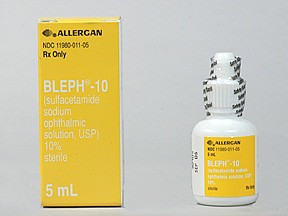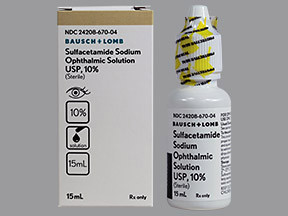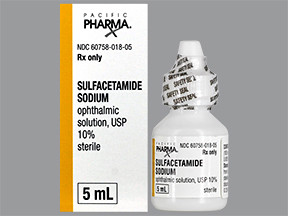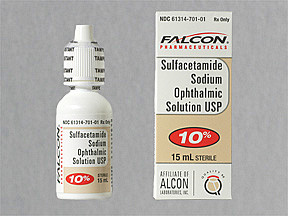SULFACETAMIDE DROPS - OPHTHALMIC
PHONETIC PRONUNCIATION: (SUL-fa-SEET-a-mide)
COMMON BRAND NAME(S): Bleph-10
GENERIC NAME(S): sulfacetamide sodium
Uses
USES: This medication is used to treat bacterial eye infections (such as conjunctivitis). It belongs to a class of drugs known as sulfa antibiotics. Sulfacetamide works by stopping the growth of bacteria. This medication treats only bacterial eye infections. It will not work for other types of eye infections. Unnecessary use or misuse of any antibiotic can lead to its decreased effectiveness.
How to use SULFACETAMIDE DROPS - OPHTHALMIC
HOW TO USE: Before using, check this product visually for discoloration. If the product is discolored, do not use the liquid. To apply eye drops, wash your hands first. To avoid contamination, do not touch the dropper tip or let it touch your eye or any other surface. Use in the eyes only. Do not swallow or inject. Do not wear contact lenses while you are using this medicine. Sterilize contact lenses according to manufacturer's directions, and check with your doctor before you begin using them again. Tilt your head back, look upward, and pull down the lower eyelid to make a pouch. Hold the dropper directly over your eye and place one drop into the pouch as directed by your doctor. Look downward, gently close your eyes, and place one finger at the corner of your eye (near the nose). Apply gentle pressure for 1 to 2 minutes before opening your eyes. This will prevent the medication from draining out. Try not to blink or rub your eye. Repeat these steps for your other eye if so directed or if your dose is for more than 1 drop. Wait several minutes for your vision to clear before driving or operating machinery. Do not rinse the dropper. Replace the dropper cap after each use. The dosage is based on your medical condition and response to treatment. Your doctor may direct you to use this medication more often at first, then use it less frequently as the infection improves. Follow your doctor's directions carefully. Your doctor may direct you to use sulfacetamide drops during the day and the ointment at bedtime. If you are using another kind of eye medication (such as drops or ointments), wait at least 5 minutes before applying other medications. Use eye drops before eye ointments to allow the drops to enter the eye. Use this medication regularly in order to get the most benefit from it. To help you remember, use it at the same times each day. Continue using it for the full time prescribed, usually 7 to 10 days. Stopping the medication too soon may allow the bacteria to continue to grow, which may result in a return of the infection. Tell your doctor if your condition persists or worsens.
Side Effects
Precautions
Interactions
Overdose
Images
Reviews
Faq for SULFACETAMIDE DROPS - OPHTHALMIC
Sulfacetamide Drops are used to treat bacterial infections of the eye, including conjunctivitis and blepharitis.
You should wash your hands before using the drops. Tilt your head back, pull down your lower eyelid to create a small pocket, and then squeeze the prescribed number of drops into the pocket. Close your eyes and gently press on the inner corner of your eye with your finger for about 1-2 minutes to prevent the drops from draining into your tear duct. Avoid touching the dropper tip to any surface to prevent contamination.
The duration of treatment will depend on the severity of the infection and the instructions given by your doctor. Generally, treatment with Sulfacetamide Drops lasts for 7-10 days. It is important to complete the full course of treatment, even if your symptoms improve before the medication is finished.
Common side effects of Sulfacetamide Drops include temporary stinging or burning in the eyes, blurred vision, and eye irritation. These side effects are usually mild and go away on their own. However, if you experience severe eye pain, vision changes, or signs of an allergic reaction (such as rash, itching, or swelling), seek immediate medical attention.
It is generally recommended to avoid wearing contact lenses while using Sulfacetamide Drops. However, depending on the severity of your infection and the advice of your doctor, you may be able to wear your lenses after a certain period of time. Consult your eye care professional for specific guidance.
Sulfacetamide Drops can be used in children, but the dosage and duration of treatment may need to be adjusted based on their age and weight. Follow the instructions provided by your pediatrician or eye care specialist. It is important to note that Sulfacetamide Drops should not be used in infants younger than 2 months old, as it may increase the risk of a serious blood disorder.
Yes, Sulfacetamide Drops require a prescription from a healthcare provider. They are not available over-the-counter. Do not use any eye drops without proper medical guidance.
Disclaimer
IMPORTANT: HOW TO USE THIS INFORMATION: This is a summary and does NOT have all possible information about this product. This information does not assure that this product is safe, effective, or appropriate for you. This information is not individual medical advice and does not substitute for the advice of your health care professional. Always ask your health care professional for complete information about this product and your specific health needs.




No Reviews Yet